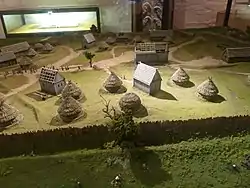| Sancti venite | |
|---|---|
| by monks at Bangor Abbey | |
| English | Come all ye holy |
| Genre | Hymn |
| Written | 7th century |
| Language | Latin |
| Meter | 10.10 |
| Published | AD 680–691 |

"Sancti venite" is a Latin Eucharistic hymn recorded in the Antiphonary of Bangor.[1]
History
"Sancti venite" was composed at Bangor Abbey in the 7th century AD, making it the oldest known Eucharistic hymn.[2]
It was carried to Bobbio Abbey and was first published by Ludovico Antonio Muratori in his Anecdota Latina ex Ambrosianæ Bibliothecæ codicibus (1697–98), when he discovered it in the Biblioteca Ambrosiana.[3]
According to a legend recorded in An Leabhar Breac, the hymn was first sung by angels at St. Seachnall's Church, Dunshaughlin, after Secundinus had reconciled with his uncle Saint Patrick.[4]
Lyrics
| Latin text | English text (tr. John Mason Neale, 1851) | |
|---|---|---|
Sancti venite, Christi corpus sumite, |
Draw nigh and take the Body of the Lord, |
References
- ↑ "Sancti, venite".
- ↑ Healy, Rev John (8 June 2016). "Insula Sanctorum Et Doctorum Or Ireland's Ancient Schools And Scholars". Read Books Ltd – via Google Books.
- ↑ "Bangor, Light of the World, 11: Patrick of Lecale - Dr. Ian Adamson OBE".
- ↑ "Celtic and Old English Saints - 10 May".